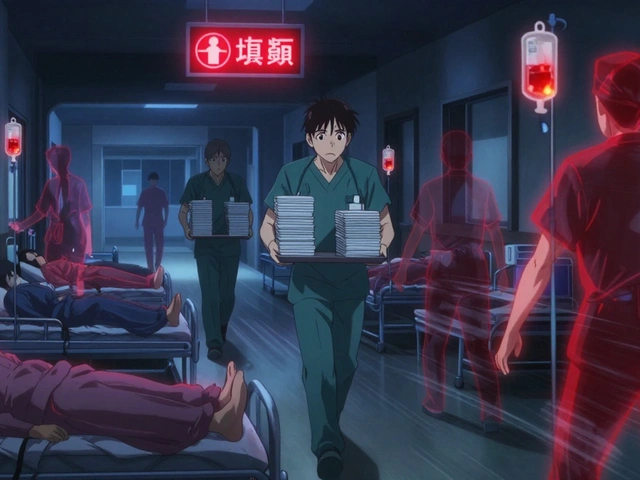
Betapace (sotalol) is a medication used to treat serious heart rhythm problems like ventricular tachycardia and atrial fibrillation. It’s not a first-choice drug for everyone - but for some people, it’s the only thing that keeps their heartbeat steady. If you’ve been prescribed Betapace, you’re probably wondering: are there better, safer, or simpler options? The answer isn’t simple. It depends on your heart condition, your other health issues, and how your body reacts to drugs.
How Betapace Works
Betapace is a class III antiarrhythmic with beta-blocking properties. That means it does two things at once: it slows down your heart rate (like a beta-blocker) and lengthens the time between heartbeats (like amiodarone or dofetilide). This dual action makes it effective for both fast and irregular heart rhythms. But it also makes it risky. Betapace can cause a dangerous heart rhythm called torsades de pointes, especially if you have low potassium, kidney problems, or take other drugs that affect your heart’s electrical system.
The FDA requires patients on Betapace to start in a hospital under heart monitoring. Why? Because about 1 in 50 people on the drug develop a life-threatening rhythm change within the first few days. That’s not rare - it’s common enough that doctors won’t just hand you a prescription and send you home.
Why People Look for Alternatives
People switch from Betapace for three main reasons:
- Side effects: fatigue, dizziness, shortness of breath, or a slow heartbeat that’s too slow.
- Drug interactions: Betapace doesn’t mix well with many common meds, including antidepressants, antibiotics, and even some antacids.
- Monitoring burden: You need regular ECGs, blood tests for potassium and kidney function, and frequent doctor visits.
For many, the hassle and risk feel heavier than the benefit. That’s when they start asking: what else works?
Alternative 1: Amiodarone
Amiodarone is the most powerful antiarrhythmic available. It’s often used when Betapace fails or isn’t safe. It works on multiple heart channels, making it effective for almost any rhythm problem - even ones that don’t respond to other drugs.
But amiodarone comes with a long list of problems. It can damage your lungs, liver, thyroid, and eyes. Some people take it for years and develop thyroid dysfunction or vision changes. It also builds up in your body over time, so side effects can show up months after you start taking it.
Unlike Betapace, you don’t need hospital monitoring to start amiodarone. But you do need monthly blood tests and annual lung scans. It’s a long-term commitment with serious trade-offs.
Alternative 2: Dofetilide
Dofetilide is another class III drug, just like Betapace. It’s used mainly for atrial fibrillation. It doesn’t block beta receptors, so it won’t slow your heart as much - which can be better if you’re already prone to low blood pressure or fatigue.
Here’s the catch: dofetilide has the same risk of torsades de pointes as Betapace. That means you still need to start it in the hospital with heart monitoring. The big difference? Dofetilide is cleared by the kidneys, so if you have kidney disease, your dose has to be lowered - or you can’t take it at all. Betapace is cleared by both kidneys and liver, so it’s slightly more forgiving if one organ isn’t working perfectly.
Dofetilide doesn’t cause thyroid or lung issues like amiodarone. But it’s expensive. A month’s supply can cost over $500 without insurance.
Alternative 3: Flecainide
Flecainide is a class Ic antiarrhythmic. It’s great for supraventricular arrhythmias - like atrial flutter or paroxysmal AFib - especially in people with structurally normal hearts. It’s taken as a pill, twice a day. No hospital stay needed to start it.
But here’s the warning: if you have heart disease - like a past heart attack, heart failure, or blocked arteries - flecainide can increase your risk of sudden death. The CAST trial in the 1980s showed this clearly. Since then, doctors avoid flecainide in anyone with coronary artery disease.
Compared to Betapace, flecainide has fewer systemic side effects. No fatigue. No thyroid issues. But it can cause dizziness, blurred vision, or nausea. And if your heart rhythm gets worse on it, you might need an implantable device.
Alternative 4: Metoprolol or Other Beta-Blockers
If your main problem is a fast heart rate - not necessarily an irregular one - you might not need Betapace at all. Simple beta-blockers like metoprolol, atenolol, or propranolol can control heart rate in atrial fibrillation without the same level of risk.
These drugs don’t fix the rhythm - they just slow it down. That’s fine for many people who don’t have symptoms from the irregular beat itself, just from how fast their heart is going. They’re cheaper, safer, and easier to monitor. No hospital stays. No ECGs every week.
But if your heart is skipping beats or fluttering badly, beta-blockers alone won’t cut it. You’ll still need something stronger.
Alternative 5: Catheter Ablation
For people with recurrent atrial fibrillation, ablation is becoming the go-to option - even before trying multiple drugs. It’s a minimally invasive procedure where doctors use heat or cold to destroy small areas of heart tissue causing the abnormal rhythm.
Success rates for paroxysmal AFib are around 70-80% after one procedure. For persistent AFib, it’s lower - about 50-60%. Many patients still need a drug afterward, but often at a lower dose. Some stop all antiarrhythmics entirely.
Ablation isn’t for everyone. You need a healthy heart, good lung function, and the ability to lie still for 2-4 hours. But if you’re young, active, and tired of taking pills with side effects, it’s often the best long-term solution.
Alternative 6: Rivaroxaban or Apixaban (for stroke prevention, not rhythm control)
This isn’t a direct alternative to Betapace - but it’s often part of the bigger picture. People with atrial fibrillation are at higher risk for stroke. Betapace doesn’t prevent clots. Blood thinners like apixaban (Eliquis) or rivaroxaban (Xarelto) do.
Many patients on Betapace also take one of these. But newer guidelines say: if you’re on a blood thinner and your rhythm is controlled with a beta-blocker, you might not need a strong antiarrhythmic at all. The goal isn’t always to restore perfect rhythm - sometimes it’s just to prevent stroke and keep your heart from racing.

When Betapace Is Still the Best Choice
Betapace isn’t outdated. It still has a place. It’s often used when:
- You have both atrial fibrillation and ventricular arrhythmias.
- You’ve tried other drugs and they failed or caused side effects.
- You have structural heart disease but can’t take amiodarone due to lung or thyroid concerns.
- Your kidneys are fine, but your liver isn’t - Betapace is cleared by both, so it’s safer than some alternatives.
It’s also used in patients with long QT syndrome - though that’s rare. In those cases, Betapace can actually shorten the QT interval, which is the opposite of what most drugs do.
Key Factors in Choosing an Alternative
Here’s what your doctor should consider before switching you:
- Heart structure: Do you have heart failure, past heart attack, or valve disease? That rules out flecainide.
- Kidney function: If your creatinine clearance is below 40 mL/min, dofetilide and sotalol may be unsafe.
- Other meds: Are you on antidepressants, antibiotics, or antifungals? Many interact dangerously with Betapace.
- Age: Older adults are more sensitive to side effects. Beta-blockers or ablation may be better than strong antiarrhythmics.
- Goals: Do you want to restore normal rhythm? Or just control heart rate? Your answer changes everything.
What to Ask Your Doctor
If you’re on Betapace and thinking about alternatives, here are five questions to ask:
- What’s my main problem - fast heart rate, irregular rhythm, or both?
- Have I been tested for kidney or liver function recently?
- What are the risks of continuing Betapace versus switching?
- Is ablation an option for me? What’s the success rate in my case?
- Can I try a simpler drug first - like metoprolol - before moving to something stronger?
Don’t stop Betapace on your own. Stopping suddenly can cause rebound arrhythmias - sometimes worse than before.
Bottom Line
Betapace is effective, but it’s not the easiest or safest drug out there. For many, alternatives like beta-blockers, ablation, or even just a blood thinner offer better quality of life with less risk. Amiodarone is powerful but toxic. Dofetilide is similar to Betapace but harder on the kidneys. Flecainide works well - if your heart is otherwise healthy.
The right choice isn’t about which drug is strongest. It’s about which one fits your body, your lifestyle, and your goals. Talk to your cardiologist. Get your kidney and liver numbers checked. Ask about ablation. And don’t assume the first drug you’re given is the only option.
Is Betapace still commonly prescribed today?
Yes, but less often than before. Betapace is still used, especially in patients with both atrial and ventricular arrhythmias, or when other drugs fail. However, due to its risks and monitoring requirements, doctors now prefer simpler options like beta-blockers or catheter ablation when possible. It’s no longer a first-line choice for most new patients.
Can I switch from Betapace to amiodarone safely?
Switching from Betapace to amiodarone requires careful planning. Both drugs affect heart rhythm, so overlapping them can increase the risk of dangerous arrhythmias. Doctors usually stop Betapace for several days before starting amiodarone. Blood tests and ECGs are needed before and after the switch. Amiodarone also takes weeks to reach full effect, so your heart rhythm may become unstable during the transition.
Do I need to avoid certain foods or supplements with Betapace?
Yes. Avoid grapefruit juice - it can interfere with how Betapace is processed. Also, don’t take potassium supplements unless your doctor tells you to. Low potassium increases the risk of torsades de pointes. High potassium can cause dangerous slowing of the heart. Stick to a balanced diet and avoid herbal supplements like St. John’s wort or licorice root, which can interact with heart medications.
Is ablation better than taking Betapace long-term?
For many people with recurrent atrial fibrillation, yes. Ablation has a higher chance of eliminating the rhythm problem without daily drugs. Studies show that after one ablation, about 70% of patients with paroxysmal AFib stay in normal rhythm without medication. That’s better than most drugs, including Betapace. But ablation isn’t perfect - some need a second procedure, and it’s not suitable for everyone with severe heart disease.
What are the signs Betapace isn’t working for me?
If you still feel your heart racing, fluttering, or skipping beats despite taking Betapace, it may not be working. Other signs include worsening fatigue, dizziness when standing, or shortness of breath during light activity. If you notice these, contact your doctor. Don’t wait. Your rhythm may be changing, or your dose may need adjustment. Sometimes, it’s not that the drug failed - it’s that your heart condition has progressed.
Write a comment
Your email address will not be published.





12 Comments
Look, I get it - Betapace is a beast. I was on it for 18 months after my ablation failed. The hospital monitoring? Worth it. The weekly ECGs? Hell no. But here’s the thing nobody says: if your heart’s been through a war, sometimes you need a tank, not a bicycle. Amiodarone might rot your thyroid, but it kept me alive when metoprolol turned me into a zombie. I’m not saying it’s pretty - I’m saying it’s real.
One must interrogate the epistemological foundations of pharmacological hierarchy in arrhythmia management. The privileging of 'simpler' agents like beta-blockers reflects a neoliberal reductionism in cardiac care - a commodification of clinical complexity into digestible, cost-efficient binaries. Flecainide is not 'risky' - it is *contextually inappropriate* in the presence of structural disease, a distinction often conflated by lay discourse. The FDA’s hospitalization mandate for sotalol is not bureaucratic overreach - it is a moral imperative in the face of torsades de pointes’ unforgiving lethality.
Just got off Betapace last week. Felt like my heart was a drum solo I didn’t sign up for. Switched to metoprolol. Now I just feel tired. Not dead tired. Just... meh. Still alive. That’s the win.
Bro, I’m from India and my cardiologist here doesn’t even have the budget for dofetilide. Betapace is the only thing we can get without waiting 3 months. We don’t have ablation centers in every city. So yeah, we deal with the monitoring. My mom says, ‘If the medicine keeps your heart beating, you don’t complain about the paperwork.’ 😊
People act like Betapace is some evil monster, but they’re the ones who refuse to do the work. You want to avoid hospital monitoring? Then don’t have a dangerous arrhythmia. You want to skip the blood tests? Then don’t eat grapefruit, don’t take random supplements, and don’t act like your heart is a toy you can tweak with Google. I’ve seen too many people blame the drug instead of taking responsibility. Betapace isn’t the problem - it’s the people who treat their hearts like they’re smartphones.
My aunt had AFib for 12 years and was on everything - Betapace, amiodarone, you name it. She cried every time she had to get blood drawn. Then she did ablation. Two years later? No meds. Just walks 5 miles every morning, dances with her grandkids, and says, ‘I didn’t know my heart could feel this light.’ Sometimes the best pill is the one you never have to swallow again 💪❤️
Let me tell you why this whole article is a scam. Betapace? Overrated. Amiodarone? Toxic trash. Ablation? A $$$ racket. The real answer? You’re all missing the forest for the trees. The problem isn’t the drugs - it’s that nobody tells you to fix your lifestyle. You’re sitting on a couch eating chips, drinking soda, sleeping 5 hours, and then wondering why your heart is acting up. No drug fixes bad sleep. No ablation fixes chronic stress. No blood thinner fixes obesity. You want to stop Betapace? Start walking. Stop sugar. Breathe. Sleep. Then come back and tell me you still need it. I’ll wait.
And don’t even get me started on ‘simpler’ beta-blockers. Metoprolol doesn’t fix rhythm - it just numbs the symptoms like a placebo with side effects. You think your doctor’s trying to help you? They’re just tired of hearing you complain. They give you metoprolol because it’s cheap, not because it’s right. Meanwhile, your atrial fibrillation is slowly turning into heart failure. And you’re nodding along like it’s all fine.
I’ve been through all of this. I took amiodarone for three years. My thyroid turned into a malfunctioning toaster. My lungs sounded like a rusty bellows. I lost my hair. I couldn’t taste anything. But I didn’t quit. I changed my diet. I started yoga. I meditated. I slept 8 hours. And guess what? My arrhythmia went from 80% of the day to less than 5%. I’m off all drugs now. Not because of some fancy procedure. Because I stopped being a victim and started being a human.
So no, Betapace isn’t the villain. The villain is the system that sells you pills instead of power. The villain is the doctor who doesn’t ask about your sleep. The villain is you, scrolling through Reddit instead of walking outside. The drugs are just the Band-Aid on a bullet wound.
And before you say ‘but I have heart disease’ - yeah? So did my uncle. He walked 2 miles a day for 5 years. He’s 82 now. Still gardening. Still laughing. Still not on a single antiarrhythmic. Your heart isn’t broken. You’re just out of shape. And that’s not a medical problem. That’s a life problem.
Thank you for this comprehensive and clinically nuanced overview. As a registered nurse in cardiac telemetry, I can attest to the critical importance of structured initiation protocols for sotalol. The incidence of torsades de pointes during the first 72 hours remains a sobering reality, and the multidisciplinary coordination required - from pharmacy to ECG tech to nephrology - is often underappreciated. I’ve witnessed patients transition successfully to ablation, but only after exhaustive pharmacologic trials and meticulous risk stratification. This is not a decision to be made lightly, nor should it be reduced to a ‘better drug’ narrative. It is a journey of individualized cardiac resilience.
Hi everyone! ❤️ I just wanted to say how grateful I am for this thread - it’s so comforting to know I’m not alone in this. I’ve been on Betapace for 2 years and honestly? I thought I was the only one who felt like a science experiment. But reading your stories? It gives me hope. I’m scheduled for ablation next month and I’m terrified… but also excited. You’re all inspiring. Keep going, keep asking questions, and don’t give up. You’re stronger than your heart rhythm. 💪🌸
amiodarone is toxic but its the only thing that works for me after 3 failed ablations and betapace gave me QT prolongation so i switched and now i have hypothyroidism and lung fibrosis but at least my heart is in sinus and i dont die every other week so what do you want me to do
Andrea, you’re not alone. I’ve been on amiodarone for 7 years. Thyroid? Check. Liver enzymes? Always up. Vision? Blurry. But my AFib? Gone. You don’t get to pick the side effects - you pick the survival. And if you’re still breathing, you won.
I was on Betapace for 8 months. My doctor said ‘it’s working’ - but I was dizzy all day, couldn’t climb stairs, and my heart felt like it was drowning. I quit cold turkey because I couldn’t take it anymore. Two days later? Ventricular tachycardia. ER. Defibrillator. ICU. Now I’m on metoprolol and I’m alive. But I swear - if I ever feel like quitting again, I’m calling my doctor first. No more heroics. I learned the hard way.